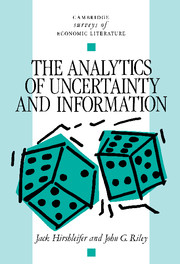Book contents
- Frontmatter
- Contents
- Acknowledgments
- Introduction: The economics of uncertainty and information
- Part I
- Part II
- 5 Information and informational decisions
- 6 The economics of emergent public information
- 7 Research and invention
- 8 Informational asymmetry and contract design
- 9 Strategic uncertainty and equilibrium concepts
- 10 The economics of contests
- 11 Competition and hidden knowledge
- 12 Long-run relationships and the credibility of threats and promises
- Index
9 - Strategic uncertainty and equilibrium concepts
Published online by Cambridge University Press: 05 June 2012
- Frontmatter
- Contents
- Acknowledgments
- Introduction: The economics of uncertainty and information
- Part I
- Part II
- 5 Information and informational decisions
- 6 The economics of emergent public information
- 7 Research and invention
- 8 Informational asymmetry and contract design
- 9 Strategic uncertainty and equilibrium concepts
- 10 The economics of contests
- 11 Competition and hidden knowledge
- 12 Long-run relationships and the credibility of threats and promises
- Index
Summary
For the most part, the analysis to this point has dealt with event uncertainty. Individuals were mainly uncertain about Nature's choice of state of the world. In the following chapters the focus shifts to strategic uncertainty, where what is best for individual A to do depends upon individual B's choice, and vice versa. So the main risks that a person has to deal with concern the actions and reactions of others. A first step is the choice of an equilibrium concept for such an environment, which turns out to be a subtle and still controversial issue. As usual, our discussion will not attempt to address formal issues of existence or uniqueness of equilibrium. Our aim instead is to provide an intuitive interpretation of the key ideas.
Nash equilibrium
In a coordination game the parties' interests are completely parallel. A specific example known as “Tender Trap” (Hirshleifer, 1982) is illustrated in table 9.1. Here the two parties both gain by coordinating their activities, but they do better by agreeing upon one of the options rather than the other. An example: The Dvorak typewriter keyboard is, it has been claimed, ergonomically superior to the currently standard “Qwerty” arrangement. But having settled on the current standard keyboard, largely by historical accident, now manufacturers are supposedly reluctant to produce Dvorak keyboards so long as almost all typists are trained on Qwerty, while typists don't want to train on Dvorak when almost all keyboards are Qwerty.
- Type
- Chapter
- Information
- The Analytics of Uncertainty and Information , pp. 330 - 368Publisher: Cambridge University PressPrint publication year: 1992



